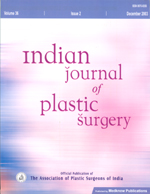
|
Indian Journal of Plastic Surgery
Medknow Publications on behalf of Indian Journal of Plastic Surgery
ISSN: 0970-0358
EISSN: 0970-0358
Vol. 43, No. 1, 2010, pp. 21-27
|
 Bioline Code: pl10006
Bioline Code: pl10006
Full paper language: English
Document type: Research Article
Document available free of charge
|
|
|
Indian Journal of Plastic Surgery, Vol. 43, No. 1, 2010, pp. 21-27
| en |
A modified tubularised incised plate urethroplasty technique and a revised hypospadias algorithm
Bhattacharya, Sameek
Abstract
To simplify and standardize surgical management of hypospadias, a modified tubularised incised plate (TIP) urethroplasty (Snodgrass) technique has been described and a revised hypospadias management algorithm has been formulated. The study aims to evaluate the viability of the described procedure in different types of hypospadias and tests the validity of the algorithm. The modification described is recruitment of penile and glandular skin lateral to the urethral plate to facilitate tubularisation. The algorithm starts with penile degloving with preservation of urethral plate. Snodgrass repair was done in cases with no chordee and where skin chordee resolved by skin take down. Modified Snodgrass repair was done in cases where urethral plate was narrow. Another modification proposed by us is single layer penile skin closure instead of an added dartos flap, which was done in both classical and modified Snodgrass repair. Cases of severe chordee not resolved by skin take down were repaired by transverse preputial island flap (TPIF) and Bracka′s technique. Dorsal plication was not used as an orthoplasty modality. It was possible to repair 68.89% of the cases by Snodgrass repair. These patients either had no chordee or had superficial skin tethering (skin chordee) which resolved on degolving. All these cases were coronal, distal and mid penile hypospadias. Remaining cases were mid, proximal and penoscrotal with true fibrous chordee and were repaired by TPIF or Bracka′s technique. The Snodgrass technique had a fistula rate of 9.67%. Acceptably, low fistula rate and simple execution make the proposed modification of classical Snodgrass repair a viable option. The proposed algorithm proves to be a useful tool for standardised and logical preoperative decision making. It also defines indications of the three techniques vis-a-vis the type of hypospadias.
Keywords
Algorithm; chordee; hypospadias; snodgrass; urethroplasty
|
| |
© Copyright 2010 Indian Journal of Plastic Surgery.
Alternative site location: http://www.ijps.org/
|
|
